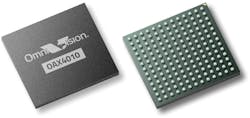Image Signal Processor Addresses HDR, LED Flicker Mitigation
To better understand the design issues addressed by the new OmniVision image signal processor (ISP), it’s necessary to quickly review vision/imaging concerns that show up in an automotive environment.
Image sensor applications include advanced driver-assistance systems (ADAS) such as assisted parking, rear-view cameras, surround-view systems, and machine vision. Machine-vision cameras and related technology will play an important role in not only the safety of autonomous vehicles, but in their ability to account for unexpected events while driving.
Image quality plays a crucial role in machine-vision applications. Too often, image sensors can’t reproduce the full dynamic range of the scene, causing under- or over-saturation in the captured image due to the sensor’s inherent low dynamic range. Achieving high dynamic range (HDR) involves the simultaneous capture of bright and dark areas in the same frame and the ability to combine multiple captures without sacrificing signal-to-noise ratio or introducing artifacts.
LED flicker occurs when a light source is being powered by a pulse-width-modulated (PWM) signal. LED lights may pulse several hundred times a second with varying duty cycles—the fraction of one period when the light is active. At frequencies greater than 90 Hz, the light will usually appear to be constant to most human observers. A camera capturing the pulsed light source, however, may require a shorter exposure time than the temporal “on” period of the PWM.
For a camera monitor system that may replace a conventional vehicle mirror, flickering LED headlamps may be mistaken for turn signals and indicators. That can lead to the misinterpretation of a scene by a machine-vision algorithm.
With the widespread use of LEDs for front and rear automotive lighting LED flicker mitigation (LFM) capability assures that pulsed light sources do not appear to flicker.
HDR/LFM Combo Algorithm
OmniVision Technologies’ OAX4010 automotive ISP features a new HDR and LFM Engine (HALE) combination algorithm (see figure). In tandem with the company’s OX01A10 and OX02A10 LFM image sensors, the OAX4010 enables more intelligent decision-making by providing simultaneous LFM and HDR capability while operating over the automotive temperature range.
Thanks to its HDR and LFM Engine (HALE), the OAX4010 image signal processor brings high dynamic range and LED flicker mitigation to automotive vision systems.
In addition, the OAX4010 can process the images from one camera at 60 frames/s or two cameras at 30 frames/s. This reduces the number of ISPs required for surround-view-system (SVS) cameras by 50%.
Simultaneous HDR and LFM capability is important in enhancing safety, as it ensures that potential hazards can be identified in both very dark and very bright areas of the scene.
“With the ongoing transition from SoCs to standalone ISPs for automotive viewing, these systems are increasingly incorporating ADAS requirements such as LFM and HDR,” says Pierre Cambou, principal imaging analyst at Yole Développement. “The ability to provide state-of-the-art companion ISPs is becoming a key technology requirement for image sensor suppliers to automotive Tier ones and OEMs, as they tackle the numerous new features like parking assist and e-mirrors.”
Flicker-Free and Temp-Rugged
According to OmniVision, existing HDR combining algorithms can’t guarantee that the combined HDR images are LED flicker-free. As such, designers were forced to choose between optimizing flicker mitigation or dynamic range, especially at temperatures above 80°C. With the OAX4010, designers can provide drivers with additional bright and dark scene details while eliminating LED flicker, thus increasing safety.
The ability to provide LFM and HDR at high temperatures is important because applications like e-mirrors are often running continuously in extreme temperature conditions. The OAX4010 also enables the emerging augmented-reality (AR) camera systems to overlay real-time images on GPS navigation displays, which requires LED traffic signs and signals to be flicker-free.
“With our ISP’s proprietary HALE combination algorithm, automotive designers can create camera systems without compromise that are flicker-free while achieving the full dynamic range,” says Andy Hanvey, director of automotive marketing at OmniVision. “LFM and HDR can be optimized together to give drivers a better picture of their surroundings.”
When the OAX4010 is paired with OmniVision’s OX01A10 and OX02A10—said to be the only LFM image sensors offered in chip-scale packages in mass production today—this combination offers a compact solution for the smallest possible camera footprint. What’s more, the new ISP is pin-to-pin compatible with OmniVision’s previous-generation ISPs, providing an easy migration path to improved LFM and HDR performance with faster time to market.
The OAX4010 allows Tier-1 automotive manufacturers to design one camera that can be used in both surround-view systems and e-mirrors. This creates greater economies of scale, because a single-camera platform can be deployed in multiple applications.
The OAX4010 is AEC-Q100 Grade 2 certified and ASPICE CL-2 for automotive applications. Samples are available now.



